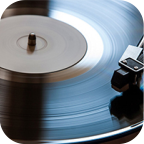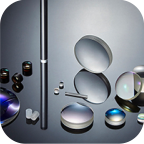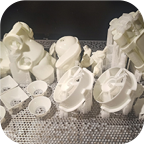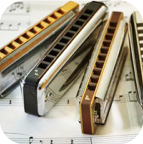Ultrasonic Cleaning Solutions for Retainers
Browse Volume:88 Classify:Support
If you wear a retainer every day—or even just a few nights a week—you already know how quickly it can collect a strange combination of plaque, saliva, food particles, and bacteria. Unlike toothbrushes or eyeglasses, retainers sit in your mouth for hours at a time, making them uniquely vulnerable to biofilm formation, mineral buildup, and microbial colonization.
Most retainers are made from acrylic, polyurethane, or thermoplastic materials, sometimes with embedded metal wires. These materials are safe in your mouth but not immune to staining, odor absorption, or microbial surface adherence. Over time, even well-rinsed retainers can develop a white or yellow chalky residue, or worse, an invisible biofilm that may carry harmful bacteria.
This is why daily cleaning is essential, and why ultrasonic cleaning has emerged as a preferred deep-cleaning method. Manual brushing, while helpful, often fails to remove bacteria and deposits lodged in crevices and under metal wires. That’s where the microscopic cavitation bubbles from ultrasonic cleaners become uniquely effective.
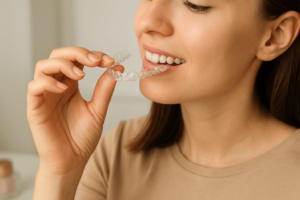
Braces
How Ultrasonic Cleaners Work with Retainers
Ultrasonic cleaners work by generating high-frequency sound waves—usually around 40,000 cycles per second (40kHz)—which pass through a liquid cleaning solution. These waves create millions of microscopic bubbles that form and collapse in a process called cavitation. When these bubbles implode near the surface of a retainer, they dislodge debris, bacteria, and biofilm from even the smallest surface irregularities.
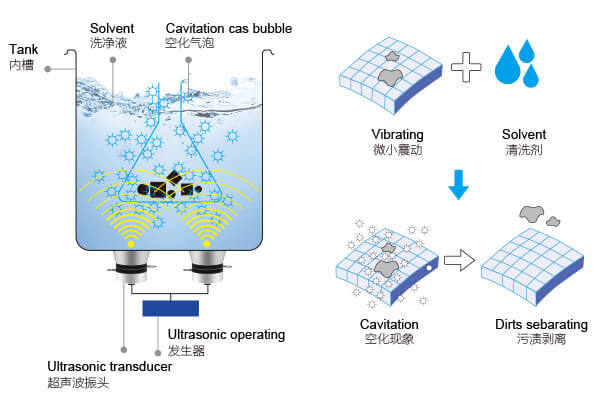
The Principle Behind Ultrasonic Cleaning
For retainers, ultrasonic cleaning offers several advantages:
- Reaches areas between bonded wires and plastic
- Removes biofilm without abrasive brushing
- Gentle enough for plastic but powerful enough to eliminate bacteria
- No need for harsh chemicals or manual scrubbing
However, it’s important to remember: the solution you put in the cleaner matters just as much as the cleaner itself. Using plain water may result in limited effectiveness, while some over-the-counter or DIY options may actually damage your retainer or irritate your mouth.
To maximize results, you need to understand what to add—and what to avoid—when cleaning retainers ultrasonically.
Can You Use Plain Water in an Ultrasonic Cleaner for Retainers?
Technically, yes—you can use just distilled or filtered water in an ultrasonic cleaner to clean a retainer. The cavitation action will still remove some visible debris and disrupt part of the biofilm. But using only water is far from optimal.
Why?
Because water lacks detergents, enzymes, or active ingredients that break down biological residues. While cavitation bubbles do provide mechanical energy, they work best when paired with a solution that can chemically weaken the bonds between proteins, minerals, and the retainer surface.
That said, using water alone is still better than nothing—especially if you’re avoiding abrasive brushing or alcohol-based solutions. But to truly sanitize a retainer, neutralize odors, and restore clarity, you need the right additive in your ultrasonic cleaner.
What to Put in an Ultrasonic Cleaner for Retainers Safely
Choosing the right solution for your ultrasonic cleaner isn’t about guessing—it’s about finding a balance between effectiveness and material safety. Retainers live inside your mouth, so whatever you clean them with needs to leave no harmful residue and be gentle on both soft plastic and bonded metal.
Here are safe and dentist-recommended options:
1. Retainer or Denture Cleaning Tablets
These tablets are designed for oral appliances and often contain mild oxidizing agents and enzymes. Many are compatible with ultrasonic use. When dropped into water in the ultrasonic cleaner, they dissolve and create a gentle, fizzy solution that enhances cavitation effectiveness.
Choose tablets that are:
- Free of alcohol and harsh bleach
- pH balanced
- Marketed as safe for retainers or dentures
Some popular options include those from brands like Polident, Retainer Brite, or Steraligner (always verify on the label if ultrasonic-safe).
2. Non-alcoholic Retainer Cleaning Concentrates
Certain cleaning fluids are sold in small bottles and are intended to be diluted in an ultrasonic tank. These often include mild surfactants, chlorhexidine, or natural enzymes that are effective at removing biofilm.
Look for:
- BPA-free, non-foaming formulas
- No peroxide or alcohol content
- Approval or recommendation from dental associations
3. Diluted Clear Antibacterial Dish Soap
While not ideal for daily use, a drop or two of fragrance-free, non-moisturizing dish soap (like clear Dawn) diluted in warm water can work in a pinch. This can help cut through oily buildup, but be sure to rinse thoroughly after cleaning.
Avoid anything with added fragrance, colorants, bleach, or moisturizing agents.
4. Hydrogen Peroxide (Carefully and Occasionally)
A very dilute hydrogen peroxide solution (no more than 3%, mixed 1:1 with water) can offer antimicrobial benefits. However, peroxide can dry out or weaken acrylic and thermoplastics over time, so it’s best used sparingly and not for every cleaning cycle.
Each of these solutions has its strengths—some excel at odor control, others at removing biofilm or discoloration, while a few are formulated for gentle daily maintenance. The right choice often depends on your retainer type, how frequently you wear it, and your individual oral health needs. What’s clear is that all of these options are substantially more effective than plain water, especially when paired with short ultrasonic cleaning cycles and proper usage.
However, because some retainers are made of more sensitive materials or include bonded components, it’s always wise to consult your orthodontist or dentist before introducing any new cleaning agent into your routine. They can help you choose a solution that protects your retainer while supporting your overall oral health.
What to Avoid Putting in the Cleaner (And Why)
When it comes to cleaning retainers in an ultrasonic cleaner, using the wrong solution can do more harm than good. Just because something cleans your teeth or household surfaces doesn’t mean it’s safe for the sensitive materials used in oral appliances. In fact, many commonly suggested DIY solutions can actually degrade the structure of your retainer, damage its clarity, or leave behind toxic residue.
Here’s what you should absolutely avoid adding to your ultrasonic cleaner:
1. Mouthwash (especially alcohol-based)
It might seem logical—mouthwash kills bacteria, so why not clean your retainer with it? The problem is that most mouthwashes contain ethanol, menthol, or strong flavoring agents, which can dehydrate, discolor, or chemically degrade the plastic in your retainer. The dyes in many mouthwashes can also stain clear aligners and retainers permanently.
2. Vinegar or Baking Soda Mixtures
Vinegar is acidic, and baking soda is mildly abrasive. While both are popular in DIY cleaning communities, neither is ideal for use in an ultrasonic bath. Vinegar can etch the surface of thermoplastics, leaving them cloudy or brittle. Baking soda particles can scratch soft acrylics, especially when combined with ultrasonic agitation.
In addition, vinegar has a strong odor and taste that is difficult to remove completely, even after thorough rinsing.
3. Bleach or Disinfectant Cleaners
Household bleach, chlorine-based cleaners, and antibacterial surface disinfectants are too harsh for oral appliances. They can not only weaken the retainer but also leave behind toxic chemical residues that could leach into your mouth during use.
Even heavily diluted bleach solutions—sometimes suggested in forums—pose risks to both your retainer and your health. Bleach should never be used in any product that enters the oral cavity.
4. Toothpaste or Whitening Gels
Toothpaste often contains abrasive particles meant to polish enamel. In an ultrasonic bath, this abrasive effect is magnified, especially on soft plastic surfaces. The result? A foggy, scratched retainer that may harbor even more bacteria due to surface roughness.
As for whitening gels, they are designed for controlled application on teeth—not for submersion or ultrasonic activation. Using these products in your cleaner can lead to unpredictable chemical reactions.
5. Essential Oils or Oil-Based Cleaners
While “natural” may sound safe, essential oils can stain retainers, create an oily residue in your ultrasonic tank, and may cause allergic reactions when worn again. Peppermint, tea tree, and eucalyptus oils—often recommended for “freshness”—can actually cause plastic clouding or interfere with bonding between the plastic and metal components.
What Experts Say
Most dental professionals advise against any DIY solution that is not:
- pH neutral
- Specifically labeled as safe for oral appliances
- Free of harsh chemicals, solvents, and abrasives
As noted in guidance from the American Association of Orthodontists (AAO), “Cleaning solutions for removable appliances must be non-corrosive and chemically inert to the materials used in fabrication”.
When in doubt, choose a product formulated for dental devices—or stick to distilled water and approved cleaning tablets. Your retainer isn’t just a piece of plastic; it’s a precision-fitted medical device that lives in your mouth. Treating it with care protects both the retainer and your health.
Should You Add Heat When Cleaning a Retainer?
It’s a common question among ultrasonic cleaner users: does adding heat improve cleaning results for retainers? After all, heat is often associated with sterilization and degreasing. However, when it comes to cleaning oral appliances like retainers, the answer is more nuanced—and in many cases, adding heat can do more harm than good.
Why Heat Might Seem Beneficial
Heat increases the kinetic energy of water molecules, allowing cleaning solutions to act more efficiently. In industrial ultrasonic cleaning—like for metal tools or engine parts—heating the solution speeds up the breakdown of oils, grime, and biological matter. It also helps degas the liquid faster and enhances cavitation, which is the core mechanism of ultrasonic cleaning.
So it’s understandable why people might assume the same applies to dental retainers.
Why Heat Can Be a Problem
Retainers, especially those made of thermoplastic materials like polyurethane or polyethylene terephthalate glycol (PETG), are highly sensitive to elevated temperatures. Even minor temperature increases—above 40°C (104°F)—can lead to:
- Warping and loss of fit
- Surface microfractures
- Clouding or delamination
- Shortened device lifespan
That’s why most orthodontists and dental appliance manufacturers strongly discourage using heated ultrasonic cleaning cycles on removable retainers.
Acceptable Temperature Range
If your ultrasonic cleaner includes a heater, follow these safety guidelines:
- Keep water temperature below 40°C (104°F) at all times
- Use a built-in thermometer or digital temp strip to monitor
- If you accidentally heated the water, let it cool down before starting the cycle
- Never use warm tap water directly, as it may already exceed safe limits
If you’re unsure whether your device includes an automatic heater, disable heating manually or unplug the feature entirely. Many smaller household-grade ultrasonic cleaners designed for jewelry or eyeglasses do not include heating functions—which makes them safer for retainers by default.
When Is Heat Acceptable?
The only time mild heating could be acceptable is:
- When cleaning Hawley retainers (made of acrylic with a metal wire), which tolerate heat better
- When using only distilled water and no chemical solution
- If you’re cleaning the retainer case, not the appliance itself
Even in those scenarios, keep the temperature under 40°C and limit cleaning time to under 60 seconds.
Bottom Line
For retainers—especially the increasingly popular clear thermoplastic types—avoid heat altogether. Ultrasonic cleaning relies on microscopic cavitation bubbles, not boiling temperatures. A gentle, cool-to-lukewarm bath paired with a safe cleaning solution is more than sufficient to remove plaque and bacteria.
Adding heat increases the risk of irreversible damage and isn’t worth the marginal cleaning gain it might provide.
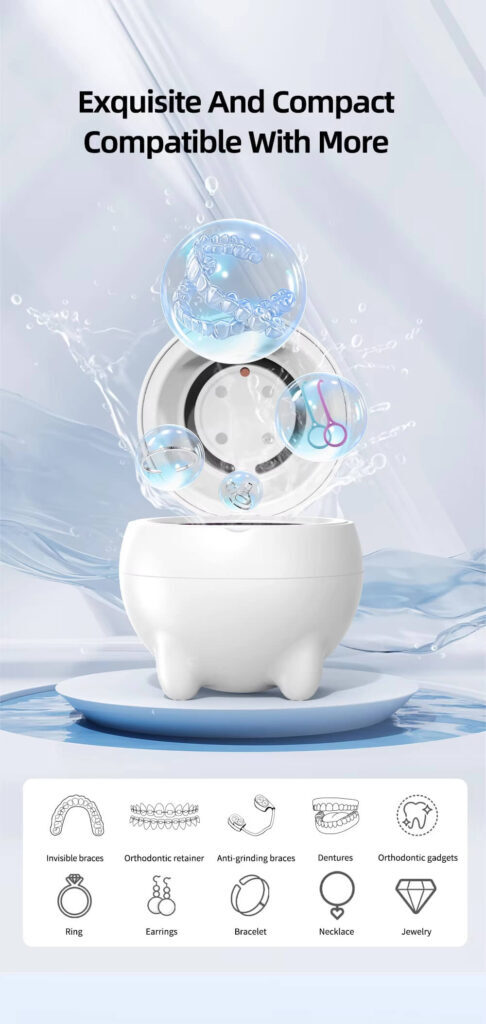
Granbo GC01 UV Ultrasonic Cleaner – 360° Deep Cleaning for Dentures, Jewelry & Household Use, with UV Light & 48kHz Frequency, 3 Modes
How Often Should You Use an Ultrasonic Cleaner on a Retainer?
Consistency is key when it comes to retainer hygiene, but frequency depends on how you wear your retainer, the type of retainer you have, and how much buildup tends to accumulate from your saliva, plaque, or diet. Ultrasonic cleaning is a powerful tool—but just like with any high-efficiency method, overuse can become counterproductive.
Daily Use: Is It Safe?
If used correctly, with gentle solutions and short cycles, ultrasonic cleaning can be used daily—especially for clear retainers worn overnight. These retainers tend to accumulate biofilm faster due to saliva pooling and overnight bacterial activity. However, the following conditions must be met for daily use:
- Cycle time is under 30 seconds
- No heat is applied
- Non-corrosive, low-strength cleaning solution is used
- Thorough rinsing after each use is practiced
If these guidelines are followed, daily ultrasonic cleaning helps prevent discoloration, odor buildup, and microbial colonization—common issues in aligner and retainer maintenance.

Granbo GC01 UV Ultrasonic Cleaner
2–3 Times a Week: The Sweet Spot for Most Users
For the average user, ultrasonic cleaning 2 to 3 times a week strikes a good balance between hygiene and device preservation. This schedule:
- Ensures biofilm doesn’t harden or stain the surface
- Reduces the need for harsh brushing or peroxide-based soaks
- Helps maintain optical clarity for clear retainers
- Minimizes chances of long-term wear from vibration exposure
This is particularly effective when paired with daily manual cleaning (brushing with water or non-abrasive soap), giving your appliance a proper deep clean without subjecting it to excessive ultrasonic exposure.
Weekly Deep Clean: For Part-Time or Backup Retainers
If you only wear your retainer occasionally—like a few nights a week—or it serves as a backup to aligners or other appliances, once-a-week ultrasonic cleaning is sufficient. In these cases:
- Rinse your retainer with cool water after each wear
- Store it in a clean, dry case away from heat and sunlight
- Use the ultrasonic cleaner for a 60-second cycle with an enzymatic tablet or soap solution weekly
Remember, retainers stored without being cleaned become a breeding ground for bacteria—even if they look clean. Weekly ultrasonic use ensures any microbial buildup is broken up and flushed away before your next wear.
Signs You May Need to Increase Frequency
You may want to clean more frequently if:
- Your retainer has developed a visible film or white deposits
- It begins to smell, even after rinsing
- You recently had a cold or sore throat, and want to sanitize
- Your orthodontist or hygienist recommends more frequent disinfection
- You eat or drink with your retainer in (which is not recommended)
In any of these situations, temporarily using the ultrasonic cleaner daily for a few days can restore cleanliness, but revert to a less frequent schedule once resolved.
When to Take a Break from Ultrasonic Cleaning
Avoid ultrasonic use temporarily if:
- The retainer shows signs of warping or cracking
- You’re waiting for a new unit after material damage
- You’ve changed to a different cleaning solution and want to test compatibility
- The ultrasonic unit is malfunctioning or overheating
Using damaged appliances in an ultrasonic cleaner can make the issues worse and even cause sharp edges that irritate the gums or cheeks.
To summarize frequency:
- Daily: Acceptable with mild solutions and short times
- 2–3×/week: Ideal for most people
- Weekly: Enough for backup retainers or part-time use
Let your mouth—and the condition of your appliance—guide your schedule.
Can Ultrasonic Cleaning Remove Tartar or Biofilm?
This is one of the most frequently misunderstood aspects of ultrasonic retainer care. People often assume that because ultrasonic cleaners are powerful, they can completely remove tartar, hardened plaque (calculus), or even stubborn biofilm on retainers. The truth is more nuanced.
Understanding the Difference Between Biofilm and Tartar
- Biofilm is a soft, slimy layer of bacteria, saliva proteins, and food residue that adheres to the surface of a retainer. It’s often invisible but can feel slightly sticky or taste unpleasant.
- Tartar, or dental calculus, is mineralized biofilm. It forms when plaque hardens due to calcium and phosphate in saliva, especially when appliances aren’t cleaned daily.
What Ultrasonic Cleaning Can Do
Ultrasonic cleaning is highly effective at removing soft and early-stage biofilm. The high-frequency sound waves create millions of microscopic cavitation bubbles that implode with force, loosening debris and bacterial colonies from the surface of the retainer.
Ultrasonic waves can also dislodge soft deposits, food particles, and early plaque buildup that hasn’t yet calcified. When used regularly, they prevent tartar from forming in the first place.
What Ultrasonic Cleaning Cannot Do
Ultrasonic cleaners cannot remove hardened tartar (calculus) once it has formed. Tartar bonds tightly to the surface of acrylic or thermoplastic retainers. No amount of vibration alone will break that bond. If your retainer has visible chalky-white or yellow deposits that don’t come off with ultrasonic cleaning, you’ll likely need one of the following:
- A manual scaling tool designed for retainer cleaning (used gently)
- A denture cleaner tablet soak (avoid strong peroxide-based versions for clear plastic)
- A visit to your orthodontist or hygienist who can clean the retainer with professional tools
In some cases, excessive tartar buildup on a clear retainer can permanently damage or stain the surface, making it unsafe or unappealing to wear. If that happens, replacement is usually the safest route.
Can Ultrasonic Cleaning Prevent Biofilm?
Yes—and that’s its biggest strength. Regular use prevents biofilm from hardening into tartar and reduces the bacterial load that contributes to bad breath, oral infections, and staining.
To optimize biofilm control:
- Clean your retainer as soon as possible after removal
- Use the ultrasonic cleaner 2–3 times per week with a mild enzymatic or antibacterial solution
- Avoid wearing your retainer while eating or drinking anything other than water, as food particles accelerate biofilm formation
If your retainer consistently smells or feels slimy even after brushing, ultrasonic cleaning will often make a noticeable difference in comfort and freshness.
Important Caution: Never Use Abrasive Cleaners
While it’s tempting to scrape or scrub hardened tartar off your retainer, avoid using:
- Toothpaste (abrasive to clear plastics)
- Baking soda (can dull and scratch the surface)
- Vinegar + peroxide combinations (can degrade plastic and corrode metal)
These may seem effective short-term but damage the retainer’s structure over time. When in doubt, consult your dental provider about safe cleaning options.
Are Over-the-Counter Retainer Tablets Safe to Use with Ultrasonic Cleaners?
As ultrasonic cleaning gains popularity among retainer users, many people wonder if common over-the-counter (OTC) cleaning tablets—like those marketed for dentures, aligners, or retainers—are safe to combine with ultrasonic devices. The answer depends on the tablet’s ingredients, your retainer’s material, and how you use the machine.
What Do These Tablets Contain?
Most OTC retainer or aligner cleaning tablets contain a blend of the following:
- Sodium bicarbonate (baking soda)
- Sodium percarbonate (oxygen-releasing compound similar to hydrogen peroxide)
- Citric acid (to break down minerals)
- Surfactants (to lift organic debris)
- Enzymes (to dissolve biofilm or food proteins)
- Flavoring agents or dyes
Some tablets also include chlorine-based agents or peroxides at higher concentrations, which can be harsh on clear thermoplastics or metal solder points in Hawley retainers.
Compatibility with Ultrasonic Cleaners
Most non-abrasive, low-foaming tablet formulas are compatible with ultrasonic use when used correctly:
- Dissolve the tablet completely in warm (not hot) water before turning on the ultrasonic cleaner
- Ensure the solution is non-corrosive—no bleach or high-concentration peroxides
- Limit cycle times to under 1 minute for clear plastic retainers, or up to 2 minutes for acrylic ones
- Rinse thoroughly with cold water after cleaning to remove chemical residues
Tablets to Avoid
Avoid the following in ultrasonic cleaning:
- Denture tablets with high-effervescence: The foaming disrupts cavitation and may damage components
- Products with abrasives or whitening agents: These can cloud clear retainers
- Chlorine-based formulas: Can degrade metal wires and stain plastics
- Vinegar or lemon juice “hacks”: These are too acidic and can warp the retainer
If you’re unsure, choose a product labeled specifically for clear aligners or plastic retainers, and check that it is approved for ultrasonic use. Brands like Retainer Brite, Invisalign Cleaning Crystals, and Steraligner often meet these criteria, but always verify the label.
Tips for Safe Use
- Do not use more than one tablet per 250–300 ml of water
- Avoid combining tablets with additional soaps or detergents
- Do not reuse the same cleaning solution for multiple cycles
- Always follow the manufacturer’s instructions for both the cleaner and the tablet
- Never exceed the recommended cleaning duration
If you’re mixing your own solution (such as diluted dish soap or enzyme powder), do not add a cleaning tablet unless the chemical interaction is known to be safe.
What If Your Retainer Looks Cloudy After Use?
If your retainer becomes cloudy or sticky after using cleaning tablets in an ultrasonic cleaner, stop immediately and:
- Rinse thoroughly
- Soak in distilled water for 30 minutes
- Switch to tablet-free ultrasonic cleaning for a few cycles
- Contact your orthodontist if the surface feels tacky or warped
Using OTC tablets in ultrasonic cleaners can significantly enhance hygiene and user comfort—but only if you choose compatible products and use them wisely. For most people, less is more: a mild tablet, a short cycle, and cool water is all it takes to keep your retainer fresh and safe.
What’s the Best Ultrasonic Cleaner for Retainers? (Features, Not Brands)
Choosing the right ultrasonic cleaner for your retainer isn’t just about price or popularity—it’s about selecting the right features that ensure effective, safe, and convenient cleaning for dental appliances. Whether you use a Hawley retainer, Essix-style clear retainer, or Vivera-like aligners, the unit’s design and specifications play a critical role in cleaning outcomes.
Let’s look at what matters most.
Frequency Range: Why 40kHz is Ideal
Ultrasonic frequency determines how aggressively cavitation bubbles act on the retainer surface. For dental applications, 35–45kHz is considered the sweet spot. Machines in this range offer:
- Enough cleaning force to remove soft biofilm and food debris
- Gentle action that won’t damage thermoplastics or wire solder joints
- Broad compatibility with cleaning solutions formulated for dental appliances
Higher frequencies (like 80kHz) produce smaller cavitation bubbles—ideal for microelectronics but less effective on larger biofilm clumps common on retainers. Lower frequencies (28kHz) may be too aggressive and risk microfractures in delicate plastics.
Tank Size and Shape
Retainers don’t require massive cleaning chambers. A tank volume of 300–800 ml is usually sufficient. However, the shape matters more than volume:
- Avoid deep, narrow tanks that cause uneven cavitation zones
- Look for shallow, wide tanks that distribute energy evenly across the retainer surface
- Rounded corners help reduce standing wave interference, improving cleaning uniformity
If your unit is too large or irregular in shape, cavitation energy may dissipate before it reaches your retainer.
Timer and Auto Shut-Off
Retainers only need short cycles—10 to 60 seconds per cleaning. A timer feature lets you:
- Avoid overcleaning (which can wear down retainer material)
- Monitor consistency across uses
- Set and forget without babysitting the machine
Look for models with digital countdown timers or at least preset cycles under 3 minutes. Auto shut-off ensures safety, especially for users who clean their retainers while multitasking.
Heat Function: Use with Caution
Many ultrasonic cleaners include a built-in heating element, but for retainers, this is usually unnecessary and potentially risky:
- Heat can deform plastic retainers, especially if water exceeds 40°C (104°F)
- Temperature control in budget ultrasonic units is often inaccurate
- Most effective cleaning for dental appliances occurs at room temperature or lukewarm (30–35°C)
If your cleaner has a heating function, ensure it can be switched off or controlled manually. Never run a cleaning cycle with hot water unless directed by your dentist or the cleaning solution manufacturer.
Material and Build Quality
Always choose a unit with a stainless steel tank. Plastic tanks:
- Do not transmit ultrasonic waves effectively
- Are prone to chemical damage from cleaning solutions
- Have shorter lifespans and less consistent energy distribution
A lid with a tight seal and non-slip base is also helpful, especially if you clean your retainer near sinks or shared countertops.
Additional Features Worth Considering
- Digital display for temperature and timer
- Quiet operation, especially for nighttime or shared spaces
- Removable basket to suspend retainers off the tank floor
- Compact design for portability and easy storage
- CE or FDA certification, indicating basic quality standards
Features to Avoid
- Overly large industrial tanks (wasteful and imprecise for small items)
- Machines that only run 5-minute+ default cycles without adjustment
- Bluetooth or app-controlled units with no real benefit for dental hygiene
- Cleaners with unsealed electronics, which may short-circuit with frequent water exposure
Ultimately, the best ultrasonic cleaner for retainers is one that balances precision, safety, and usability. You don’t need the most expensive model—you need the most appropriate one for your specific appliance and cleaning routine.
Can Ultrasonic Cleaners Damage Retainers Over Time?
While ultrasonic cleaners are widely praised for their ability to keep retainers fresh and hygienic, there is growing concern among users—and even some professionals—about potential long-term effects on the materials. Can daily vibration degrade plastic? Will metal joints corrode? What’s the real risk after months or years of use?
Let’s separate myth from fact with science-backed insights.
Material Sensitivity to Cavitation Stress
Ultrasonic cleaning works through cavitation—the formation and collapse of microscopic bubbles that create scrubbing action on a retainer’s surface. This process is highly effective at dislodging biofilm and debris, but it also generates mechanical pressure on the material.
Over time, this can lead to:
- Micro-pitting on soft plastics
- Clouding or yellowing of thermoplastic surfaces
- Loosening of metal solder joints in Hawley-type retainers
- Warping or warping-prone deformation if used with heated water
The good news is that these effects are usually seen only with improper usage, such as:
- Running cycles longer than 2–3 minutes
- Using high heat settings
- Adding corrosive or abrasive chemicals
- Placing the retainer directly on the tank floor without a basket
Which Materials Are Most at Risk?
The risk of ultrasonic damage depends on the type of retainer material:
- Essix and Vivera (thermoplastic): More prone to surface dulling or tiny cracks if exposed to long cycles or heated water
- Hawley (acrylic and metal wire): Wire solder points can weaken with excessive vibration; acrylic base can develop surface scratches
- Fixed retainers (glued wire): Ultrasonic use is not applicable directly, but proxy cleaning tools may vibrate near bonding points
- Night guards (soft plastic): Susceptible to loss of shape if heated or overexposed
Note that most damage is gradual and cumulative, not instant. Therefore, if you clean your retainer in a controlled, low-stress manner, it’s unlikely you’ll experience noticeable wear for months or even years.
Manufacturer Warnings and Warranties
Some retainer and aligner manufacturers caution against ultrasonic cleaning, primarily due to:
- Lack of user control over cycle times and temperatures
- Potential liability in case of deformation or material degradation
- Incompatibility with aggressive cleaning agents used by untrained users
Always check whether your specific retainer brand explicitly permits or forbids ultrasonic use. If your orthodontist has custom-fabricated your appliance, consult them directly before beginning an ultrasonic cleaning routine.
Best Practices to Minimize Risk
To ensure your ultrasonic cleaner extends your retainer’s life rather than shortening it:
- Use only short cycles (30–60 seconds)
- Always turn off the heating function
- Use only dentist-approved or mild cleaning solutions
- Place the retainer in a mesh basket or holder, not on the tank floor
- Rinse thoroughly after every use
- Inspect your retainer monthly for cracks, loosened joints, or loss of fit
If any deformation occurs, discontinue use and consult your orthodontist. Most damage, if caught early, can be mitigated by altering your cleaning routine.
In short, ultrasonic cleaners can be a safe and effective tool for retainer hygiene—but only when used mindfully. The same cavitation energy that cleans your appliance can also harm it if overused. Like brushing your teeth too hard, the tool isn’t the problem—it’s how you use it.
Final Thoughts on Using Ultrasonic Cleaners for Retainers: Are They Worth It?
Retainer hygiene isn’t optional—it’s essential. And as more people wear orthodontic appliances for extended periods, often for life, the need for efficient, convenient, and thorough cleaning methods has never been greater. That’s where ultrasonic cleaners enter the picture. But are they truly worth investing in?
Let’s weigh the big picture.
The Pros: Why Many Say Yes
Ultrasonic cleaners deliver cleaning power that manual brushing alone can’t match, especially for complex retainer shapes or tight crevices where biofilm thrives. In just 30 to 60 seconds, a retainer can go from cloudy and smelly to crystal-clear and fresh-smelling—without damaging scrubbing or harsh chemicals.
Their benefits include:
- Thorough cleaning in places brushes can’t reach
- Time-saving convenience for busy users
- Improved breath and oral hygiene when used consistently
- Gentle on materials when used correctly
- Reduces bacterial load, helping protect oral and systemic health
For users prone to plaque buildup, poor saliva flow, or higher oral bacteria levels, this can make a significant difference.
The Caveats: Responsible Use is Key
Despite their advantages, ultrasonic cleaners are not magical fixes. When used carelessly—with long cycles, heated water, or improper cleaning solutions—they can do more harm than good. They should never fully replace brushing or rinsing, and they require maintenance like solution changes and routine machine cleaning.
They are best seen as a supplement, not a substitute—a second step in your hygiene routine that enhances, but doesn’t replace, basic care.
Additionally, the quality of the ultrasonic unit matters. Inexpensive units with poor frequency control, no timer, or inconsistent energy output can deliver uneven results—or worse, damage your retainer over time.
Who Will Benefit Most?
Ultrasonic cleaners are especially useful for:
- Individuals who wear clear retainers or aligners full-time
- Patients with metal wires or solder joints that trap debris
- Those with limited mobility or dexterity
- Users with high standards of oral hygiene
- Parents of teens who often forget to brush their retainers
But they may not be ideal for:
- Retainers with known heat sensitivity and no user control on the device
- Patients unwilling to follow proper usage instructions
- Those who already maintain perfect hygiene with manual cleaning
In short, they’re not mandatory—but they are smart.
Bottom Line
So, what’s the verdict?
Ultrasonic cleaners are a worthwhile investment for most retainer wearers—if used correctly. They combine science-backed cleaning mechanisms with ease of use, making it easier to stay consistent with oral appliance hygiene. The key is pairing them with the right solution, the right timing, and the right expectations.
They won’t sterilize your appliance, fix a cracked retainer, or make up for weeks of neglect. But they will help your retainer last longer, smell better, and keep your mouth healthier—without the scrubbing, soaking, or frustration.
And for many, that’s more than worth it.
 Granbo Sonic
Granbo Sonic


